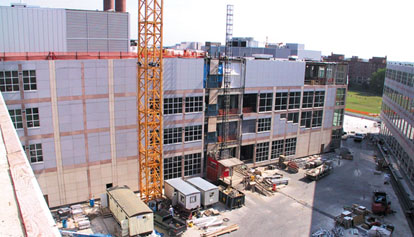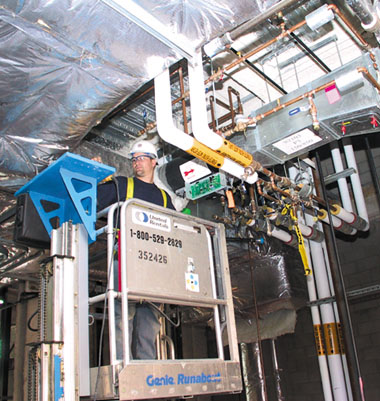Undergrad Science Building goes up on dense, immense Palmer Drive
Date Posted: August 6 2004
ANN ARBOR – The building trades and construction manager Barton Malow are helping the University of Michigan fill in one of the few open places remaining on its sprawling campus, with the ongoing construction of the Undergraduate Science Building providing another piece in the puzzle.
The L-shaped, 140,000 square-foot building is situated so that it will tie three buildings together with a plaza and a walkway in the huge Palmer Drive development. The building also links the U-M medical campus with the science corridor.
The four-story science building is packed with mechanical services that will allow more than half of the structure to serve its future mission with teaching laboratories for the school’s Department of Molecular, Cellular, and Developmental Biology as well as interdisciplinary science instructional space and support.
“It’s definitely a tight building for pipe installation,” said journeyman Doug MacDonald of Plumbers and Pipe Fitters 190 and W.J. O’Neill. “There’s a lot going in here.”
Not your common office tower, the $61 million Undergraduate Science Building has mechanical services for high and low electric cable, telecommunications, vacuum, hot and chilled water, de-ionized water, steam, natural gas, laboratory gases, acid waste as well as conventional plumbing.
“The corridor ceilings are packed with just about everything,” said Barton-Malow Project Manager Ryan Maibach. “We’re a lab building, so it’s very similar to hospital construction. We had a lot of planning and coordination before we did any work, so the installation has gone very well.”
The building is uniquely situated atop a five-level, 1,000-space parking structure that will help alleviate parking woes on campus. While trades workers have been toiling on a tight site, the clean, flat concrete atop the parking deck has provided an ideal lay-down area. The Undergraduate Science Building and nearby structures have been built with, and around, a tower crane erected on the site. Since it was built atop a swamp, a cistern is buried below the parking deck to hold runoff rainwater.
The exterior wings of the Undergraduate Science Building will match the nearby Life Sciences Institute and the Commons Buildings, using a multitude of colored masonry panels including brownstone, sandstone, limestone and granite, and painted metal panels with painted aluminum frame windows.
The new building will feature nine small classrooms and seminar rooms and 20 teaching labs, in addition to large lecture halls that will accommodate approximately 100 students each. Four of the teaching labs are set up so professors can make smooth transitions between lecture and laboratory exercises within a single class period. The university said the building will also include “plenty of public spaces to create a welcoming environment” as well as “incidental seating” for student and faculty interaction.
“In addition to having world-class research, we have to make this research available to our students and this is the building where it will happen,” said Robert Kasdin, U-M’s executive vice president and chief financial officer, at a meeting of University regents.
The project is about 50 percent complete, with completion expected in the fall of 2005, according to the university. Approximately 150 Hardhats are on the job.
“There’s just a great crew of workers out here,” Maibach said. “The site is small, and there are intense mechanical and telecommunications in here. But having such a great crew has really helped us."

The University of Michigan's $61 million Undergraduate Science Building is wedged into a tight site on the campus - and trades workers are packing numerous mechanical systems into the walls and the ceilings of the building. The tower crane, which extends 70 feet below ground, has become a permanent fixture over the last few years at the site and has been used in constructing other nearby buildings.

Running electrical metallic tubing through a crowded corridor ceiling at the U-M Undergraduate Science Center is Eric Faulhaber of IBEW Local 252 and Huron Valley Electric.
